We've always been intrigued by the EN-V autonomous pod cars proposed by General Motors.
Maybe they harken back to the happy futurism of the Fifties, or maybe it's just that they're the first total reinvention of wheeled personal transit in quite a while that makes inherent sense.
Prototyped more than two years ago under the name Project PUMA (for Personal Urban Mobility and Accessibility), the EN-V was officially launched in Shanghai early last year.
Urban, electric, autonomous
The little pods use a lithium-ion battery pack powering one or more electric motors to carry one or two people up to 25 miles at speeds of up to 35 miles an hour. In the crowded megacities of the future, that's about as fast as traffic may permit.

2010 GM EN-V Concept
They'll run in their own guideways, without other vehicles interfering, and that will allow them to drive and park autonomously by communicating with each other. This lets them not only route around or disperse traffic jams--the opposite of an insect swarm--but also travel far more closely together.
GM's concept vehicles weigh roughly 1,000 pounds, with one-third the footprint of today's standard vehicle. The two wheels, combined with Segway-like active stabilization, allow the EN-V to rotate in its own length. Materials are carbon fiber, acrylics, and Lexan.
The problem: GPS
But it turns out, according to FastCompany, there's a technical hurdle to be leaped.

PUMA prototype
No, it's not GM's. It's the resolution of the Global Positioning System (GPS) data, which is currently not nearly precise enough--at 3 meters, or almost 10 feet--to allow EN-V pods to maneuver just inches away from each other without colliding.
A GM spokesman said the company expected more precise satellite transmitters to go into service over the next decade, while the company refines the initial designs. Among other challenges, right now they're not very good in rain or snow, have minimal ground clearance, and don't climb slopes or hills well.
Not really for the U.S.
The whole EN-V concept isn't primarily meant for the United States. So please forgo the rants about [insert name of evil elected or government official] forcing [insert virtuous adjective here] Americans into [insert undesirable quality here] little pod cars that we won't even fit into anyway.
Instead, the idea of the EN-V vehicles is to make transportation practical at much higher density in the very, very crowded megacities of the future.

PUMA prototype
There are now more than a dozen megacities, and there will soon be more than two dozen, according to some projections. And 60 percent of the globe's 8 billion humans will live in them within 20 years.
Taking away tedious driving
It will also take away the tedious task of actual driving. As GM's then-R&D chief Larry Burns pointed out at the Project PUMA event, younger consumers today tend to view driving as an annoying waste of time that they could better spend ... texting.
GM hopes to begin field trials within two or three years, though the GPS issue means that a full-scale rollout isn't likely to come until the next decade.
The one possibility for U.S. usage might be in future gated communities, GM executives suggested.
+++++++++++













